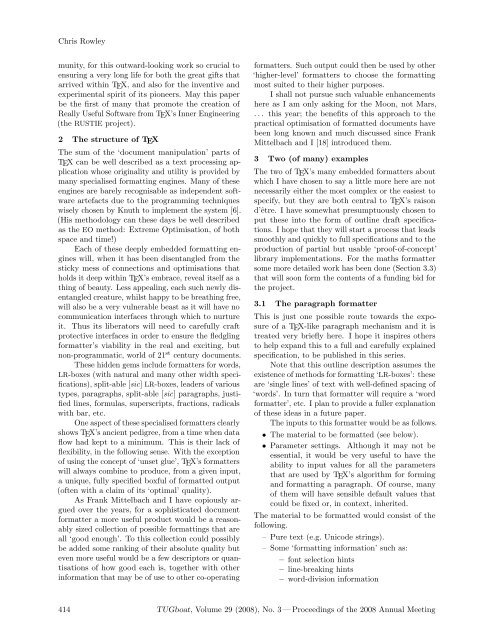The Communications of the TEX Users Group Volume 29 ... - TUG
The Communications of the TEX Users Group Volume 29 ... - TUG
The Communications of the TEX Users Group Volume 29 ... - TUG
Create successful ePaper yourself
Turn your PDF publications into a flip-book with our unique Google optimized e-Paper software.
Chris Rowley<br />
munity, for this outward-looking work so crucial to<br />
ensuring a very long life for both <strong>the</strong> great gifts that<br />
arrived within <strong>TEX</strong>, and also for <strong>the</strong> inventive and<br />
experimental spirit <strong>of</strong> its pioneers. May this paper<br />
be <strong>the</strong> first <strong>of</strong> many that promote <strong>the</strong> creation <strong>of</strong><br />
Really Useful S<strong>of</strong>tware from <strong>TEX</strong>’s Inner Engineering<br />
(<strong>the</strong> RUSTIE project).<br />
2 <strong>The</strong> structure <strong>of</strong> <strong>TEX</strong><br />
<strong>The</strong> sum <strong>of</strong> <strong>the</strong> ‘document manipulation’ parts <strong>of</strong><br />
<strong>TEX</strong> can be well described as a text processing application<br />
whose originality and utility is provided by<br />
many specialised formatting engines. Many <strong>of</strong> <strong>the</strong>se<br />
engines are barely recognisable as independent s<strong>of</strong>tware<br />
artefacts due to <strong>the</strong> programming techniques<br />
wisely chosen by Knuth to implement <strong>the</strong> system [6].<br />
(His methodology can <strong>the</strong>se days be well described<br />
as <strong>the</strong> EO method: Extreme Optimisation, <strong>of</strong> both<br />
space and time!)<br />
Each <strong>of</strong> <strong>the</strong>se deeply embedded formatting engines<br />
will, when it has been disentangled from <strong>the</strong><br />
sticky mess <strong>of</strong> connections and optimisations that<br />
holds it deep within <strong>TEX</strong>’s embrace, reveal itself as a<br />
thing <strong>of</strong> beauty. Less appealing, each such newly disentangled<br />
creature, whilst happy to be breathing free,<br />
will also be a very vulnerable beast as it will have no<br />
communication interfaces through which to nurture<br />
it. Thus its liberators will need to carefully craft<br />
protective interfaces in order to ensure <strong>the</strong> fledgling<br />
formatter’s viability in <strong>the</strong> real and exciting, but<br />
non-programmatic, world <strong>of</strong> 21 st century documents.<br />
<strong>The</strong>se hidden gems include formatters for words,<br />
LR-boxes (with natural and many o<strong>the</strong>r width specifications),<br />
split-able [sic] LR-boxes, leaders <strong>of</strong> various<br />
types, paragraphs, split-able [sic] paragraphs, justified<br />
lines, formulas, superscripts, fractions, radicals<br />
with bar, etc.<br />
One aspect <strong>of</strong> <strong>the</strong>se specialised formatters clearly<br />
shows <strong>TEX</strong>’s ancient pedigree, from a time when data<br />
flow had kept to a minimum. This is <strong>the</strong>ir lack <strong>of</strong><br />
flexibility, in <strong>the</strong> following sense. With <strong>the</strong> exception<br />
<strong>of</strong> using <strong>the</strong> concept <strong>of</strong> ‘unset glue’, <strong>TEX</strong>’s formatters<br />
will always combine to produce, from a given input,<br />
a unique, fully specified boxful <strong>of</strong> formatted output<br />
(<strong>of</strong>ten with a claim <strong>of</strong> its ‘optimal’ quality).<br />
As Frank Mittelbach and I have copiously argued<br />
over <strong>the</strong> years, for a sophisticated document<br />
formatter a more useful product would be a reasonably<br />
sized collection <strong>of</strong> possible formattings that are<br />
all ‘good enough’. To this collection could possibly<br />
be added some ranking <strong>of</strong> <strong>the</strong>ir absolute quality but<br />
even more useful would be a few descriptors or quantisations<br />
<strong>of</strong> how good each is, toge<strong>the</strong>r with o<strong>the</strong>r<br />
information that may be <strong>of</strong> use to o<strong>the</strong>r co-operating<br />
formatters. Such output could <strong>the</strong>n be used by o<strong>the</strong>r<br />
‘higher-level’ formatters to choose <strong>the</strong> formatting<br />
most suited to <strong>the</strong>ir higher purposes.<br />
I shall not pursue such valuable enhancements<br />
here as I am only asking for <strong>the</strong> Moon, not Mars,<br />
... this year; <strong>the</strong> benefits <strong>of</strong> this approach to <strong>the</strong><br />
practical optimisation <strong>of</strong> formatted documents have<br />
been long known and much discussed since Frank<br />
Mittelbach and I [18] introduced <strong>the</strong>m.<br />
3 Two (<strong>of</strong> many) examples<br />
<strong>The</strong> two <strong>of</strong> <strong>TEX</strong>’s many embedded formatters about<br />
which I have chosen to say a little more here are not<br />
necessarily ei<strong>the</strong>r <strong>the</strong> most complex or <strong>the</strong> easiest to<br />
specify, but <strong>the</strong>y are both central to <strong>TEX</strong>’s raison<br />
d’être. I have somewhat presumptuously chosen to<br />
put <strong>the</strong>se into <strong>the</strong> form <strong>of</strong> outline draft specifications.<br />
I hope that <strong>the</strong>y will start a process that leads<br />
smoothly and quickly to full specifications and to <strong>the</strong><br />
production <strong>of</strong> partial but usable ‘pro<strong>of</strong>-<strong>of</strong>-concept’<br />
library implementations. For <strong>the</strong> maths formatter<br />
some more detailed work has been done (Section 3.3)<br />
that will soon form <strong>the</strong> contents <strong>of</strong> a funding bid for<br />
<strong>the</strong> project.<br />
3.1 <strong>The</strong> paragraph formatter<br />
This is just one possible route towards <strong>the</strong> exposure<br />
<strong>of</strong> a <strong>TEX</strong>-like paragraph mechanism and it is<br />
treated very briefly here. I hope it inspires o<strong>the</strong>rs<br />
to help expand this to a full and carefully explained<br />
specification, to be published in this series.<br />
Note that this outline description assumes <strong>the</strong><br />
existence <strong>of</strong> methods for formatting ‘LR-boxes’: <strong>the</strong>se<br />
are ‘single lines’ <strong>of</strong> text with well-defined spacing <strong>of</strong><br />
‘words’. In turn that formatter will require a ‘word<br />
formatter’, etc. I plan to provide a fuller explanation<br />
<strong>of</strong> <strong>the</strong>se ideas in a future paper.<br />
<strong>The</strong> inputs to this formatter would be as follows.<br />
• <strong>The</strong> material to be formatted (see below).<br />
• Parameter settings. Although it may not be<br />
essential, it would be very useful to have <strong>the</strong><br />
ability to input values for all <strong>the</strong> parameters<br />
that are used by <strong>TEX</strong>’s algorithm for forming<br />
and formatting a paragraph. Of course, many<br />
<strong>of</strong> <strong>the</strong>m will have sensible default values that<br />
could be fixed or, in context, inherited.<br />
<strong>The</strong> material to be formatted would consist <strong>of</strong> <strong>the</strong><br />
following.<br />
– Pure text (e.g. Unicode strings).<br />
– Some ‘formatting information’ such as:<br />
– font selection hints<br />
– line-breaking hints<br />
– word-division information<br />
414 <strong>TUG</strong>boat, <strong>Volume</strong> <strong>29</strong> (2008), No. 3 — Proceedings <strong>of</strong> <strong>the</strong> 2008 Annual Meeting

















